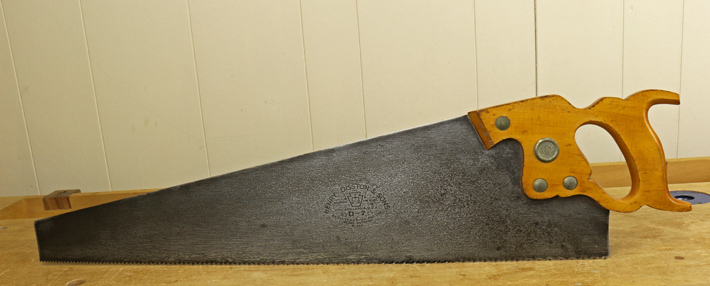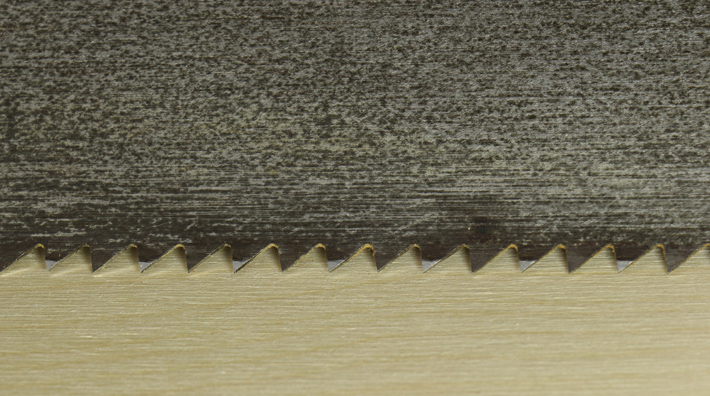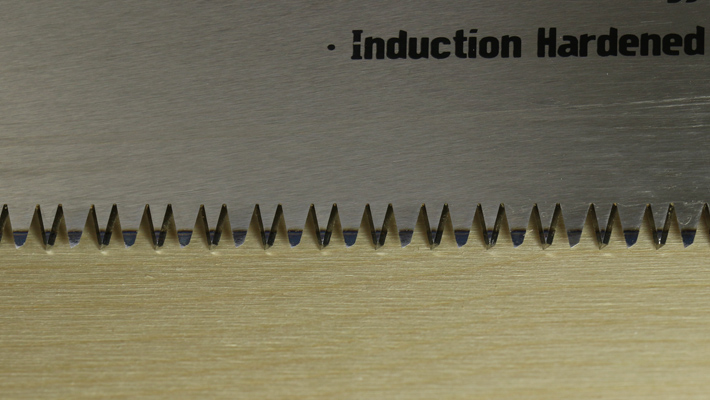Let’s look at handsaws, the most iconic of woodworking tools, from two points of view.
First, we’ll cover the basic types and anatomy. Then let’s consider just what sawing you actually need to accomplish and practical options for getting it done. Traditionalists, you’ve been warned.

The main categories of handsaws are rip and crosscut, both 24″ -26″ long. The main categories of handsaws are rip and crosscut, both 24″ -26″ long. Smaller saws, about 20″ long, of similar general design are called panel saws.
Ripsaw
The vintage 1940s Disston D-7 pictured above is an example of a classic 26″ ripsaw used for sawing along the grain. The handle is set to put power behind the coarse toothline, which is 5 1/2 points per inch. The saw plate is taper ground, which means it is progressively thinner toward both the back and the toe. This reduces binding in the kerf and permits a fairly narrow set for efficient sawing.
Rip teeth are configured like a row of tiny chisels with their edges at right angles to the length of the saw. The toothline separates the wood fibers to plow a kerf.

There are very few current makers of high-quality, full-size handsaws, and prices are in the $300 range. Acquiring a vintage saw is a more popular option. Expertly restored and sharpened saws are available in the $200 range. Saws that require fixing up are priced accordingly lower. While many woodworkers are comfortable with general sharpening, major work such as straightening is best done by a professional saw wright.
Crosscut saw
The example shown here, in marked contrast to the one above, is decidedly non-traditional. It costs all of $16, yet is remarkably effective for stock breakdown crosscutting. It will also rip but less efficiently. Other manufacturers make similar versions.

For cutting across the grain, the tooth configuration is like a row of tiny V-point knives with the bevels of alternate teeth facing each other. This allows the toothline to sever the fibers of the wood. The teeth of this saw are actually a version of Japanese-style crosscut teeth with three bevels that have been made extremely hard by a special heat treatment called induction hardening. The super sharp edges are very durable but cannot be practically resharpened by the user.

What do you need to do and what are your options in tools?
To make furniture, large boards must be cut down to smaller pieces. Here are some options for coarse and fine sawing:
Breakdown of rough lumber usually starts with crosscutting large boards to workable sizes. I suggest the cheap-and-cheerful $16 saw. I make high-end, one-of-a-kind furniture but that’s what I use because it works.
Ripping requires a lot of energy — yours or from the electric company. I usually prefer the latter so my favorite rip saw is the bandsaw for rough stock breakdown, especially if the wood is thicker than 4/4. However, a high-quality rip handsaw is a wonderful tool, and many woodworkers prefer to use hand tool processes as much as possible. With either method, the ripped edge will require smooth with a hand plane or power jointer.
For smaller, more precise crosscuts used to size parts, a large backsaw is a good choice in hand tools. These cuts can be refined by shooting, which is a key fundamental fine woodworking skill that is easily acquired. I usually prefer my accurately tuned table saw for precise crosscutting, but I often refine even these cuts by shooting, especially for precision joinery such as dovetailing.
For accurate dimensional ripping that leaves a smooth surface, the table saw is ideal. Here again, hand sawing is an alternative but the cut surface requires more planing.
But wait, there’s more!
A power jigsaw with appropriate blades is a compact and fairly inexpensive (less than a restored vintage handsaw) option for all general sawing. Ripping accuracy can be improved with a straightedge guide. Of course, the jigsaw will also serve for curved sawing work.

An all around, affordable option for hand sawing is a large bowsaw. Equipped with a wide blade, it can be used for long rip cuts simply by turning the blade 90 degrees to the frame. Here I am ripping a rough board. It’s a good workout.

Conclusion
The purpose of this series of posts is to help you assemble a tool kit that is practical and not too expensive so you can get started in woodworking. Choose the options that suit the type and scale of your projects, your budget, and the way you prefer to work. Above all, start making things!


Share tips, start a discussion or ask one of our experts or other students a question.
No Responses to “Tools to Get Started in Woodworking: Types of Handsaws”